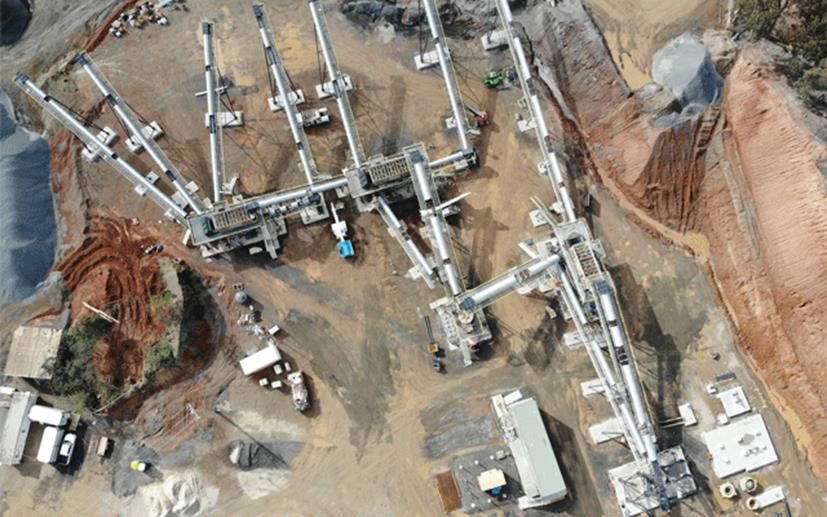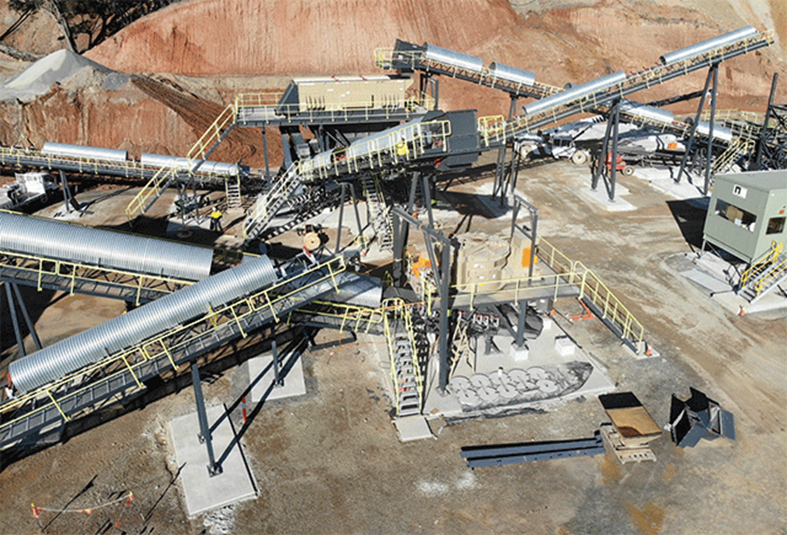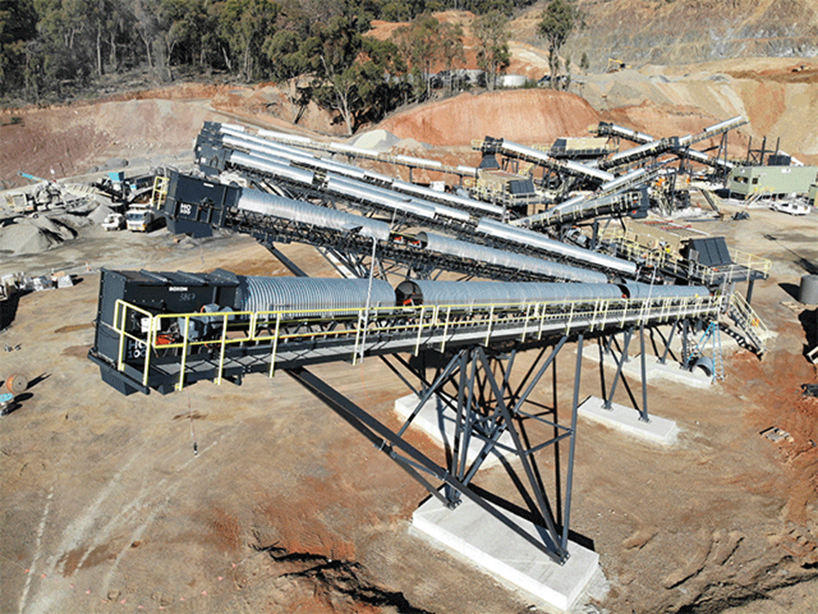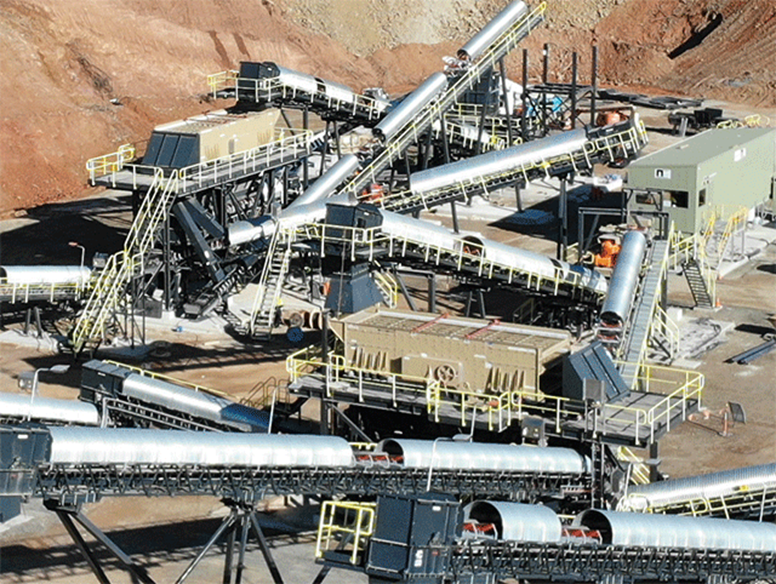
“A second generation aggregate producer is set to double its production capacity with the opening of a $15 million advanced fixed crushing and screening plant in Victoria’s Benalla region.” A report by Myles Hume for the Official Journal Of The Institute Of Quarrying Australia.
“Lima South Quarry is a second generation Victorian business, located 200km northeast of Melbourne. Its success rests largely on the extraction, crushing and screening of its in-demand hornfels blue metal aggregates, and the supply of railway ballast in the region.
The quarry first commenced commercial operation in 1998 under the ownership of Geoff and Coral Day. Their son Ashley purchased it from them in 2008 and has since overseen a significant transformation of the operation, including two extensions, taking the total extractive area to 12ha today.
Under his direction, Ashley Day has also expanded the Lima South workforce from a few men to 64 employees, seeing the operation’s annual output increase by 2500 per cent in the past eight years. A third extension application is awaiting imminent approval that would double the quarry’s footprint and extend its life for another century, based on forecasted sales.
Lima South Quarry boasts its own 10-truck transport fleet that is supplemented by about 20 sub-contract drivers who transport Lima South rock as far afield as Melbourne (200km), Mildura (540km), and Albury (150km). In keeping with the quarry’s aim to remain self-sufficient and efficient, Day has also established a NATA-accredited laboratory to test grade specifications on-site, eliminating delays associated with external testing services.
According to the company’s sales and account manager Brendan Tipple, Lima South’s flagship product is its highly sought after hornfels blue metal aggregates, which are predominantly used for asphalt, spray sealing, railway ballast and now concrete applications.
The aggregate is said to have superior properties, including a polished stone value of 60-61 for higher skid resistance, and a Los Angeles abrasion value of eight to 10. The product is only one per cent absorbent, soaking up less bitumen, binders and cement than basalt or other aggregates.

-
The secondary stage of the modern fixed plant comprises an Astec 8243-38LP horizontal screen (top, against the quarry face) and a Kodiak K400+ cone crusher (bottom right)
Pre-cast products
In addition to its annual spray sealing contracts, Lima South’s extensive list of projects include the supply of more than 200,000 tonnes of 63mm railway ballast for the Sydney to Melbourne Ballast Rehabilitation Program, as well as the recent provision of specialty leachate aggregates for construction of a new landfill cell for the local authority Benalla Rural City.
Most notably, however, Tipple said the company has been supplying Downer EDI’s asphalt plants in the region. In recent months it also has begun supplying its products to LS Precast, a related company of Lima South, located 35km north in Benalla.
Established last year, LS Precast employs more than 300 people to produce precast elements. It has secured a major contract with the Victorian Government’s $6.7 billion West Gate Tunnel project, slated for completion by the end of 2022.
“So, in effect, the aggregates from here in Lima South will be in the concrete precast panels for the West Gate tunnel, bridges and overhead roads, as well as all of the precast beams,” Tipple said. “We’ve been supplying LS Precast for the past six months or so and it is beginning to ramp up.”
Concurrently, Lima South is pursuing a contract to provide about 300,000 tonnes of railway ballast for the Australian Government’s $235 million North East Rail Line upgrade, which will see improvements to the entire rail line from Melbourne to Albury/Wodonga.
As such, this ever-increasing demand for Lima South products has been the catalyst for change.

-
The circuit comprises nearly a dozen conveyors, including Roxon HC100 bulk material belts.
Advanced replacement plant
Until now, the company had relied on significant track-mounted mobile aggregate plant. From this month (September), Lima South Quarry is set to undergo a significant operational transformation as it switches over to a new $15 million fixed crushing plant, which has been installed over two stages this year.
Astec Australia and Nepean Conveyors Roxon Australia, under a unique value based partnering arrangement, have collaborated to design, supply, deliver, install and commission the new fixed plant complete.
The turnkey scope of supply has included all structural, mechanical and electrical components for 20 fixed conveyors, as well as the structural steelwork for the crushers, feeders and screening equipment.
For Astec Australia, it is to date the largest supply of the manufacturer’s equipment in an Australian aggregate plant and showcases its range of products.
The resulting plant will double the quarry’s production capabilities, and free up the existing mobile aggregate plant for contract work that can produce between 30,000 and 40,000 tonnes per month.
Initially the plant will produce 7mm, 10mm, 14mm and 20mm aggregates, and ballast, with stage two expected to deliver further varieties of crushed rock.
The new operation, which runs off mains electricity, will considerably reduce the quarry’s diesel consumption, and will be easier to operate than the original mobile plant.
The plant’s key features include two Astec 7.3m x 2.4m (24’ x 8’) 8243-38LP horizontal screens, the first two screens of this size sold outside of the US, and a 1250mm x 3000mm (49” x 118”) Obex pan feeder. The quarry has also invested in a 4500EVTA VSI comprising twin 223kW motors, also the largest and most powerful vertical shaft impactor that Astec has supplied in Australia. Other components include a 15m x 6m (50’ x 20’) primary feeder, secondary and tertiary Kodiak K400+ cone crushers and a third horizontal screen, which is an 8203-38LP model.
Day said that “the quality of the plant, the attention to detail and level of project management and customer engagement was beyond our expectations”.
Astec Australia’s national account manager Adam Gordon said an Astec 90-tonne, tracked-mounted jaw crusher – which had been previously supplied to the quarry – has been relocated to the pit where it will now conduct in-pit primary crushing, before the material is loaded on to dump trucks and driven 300m to 400m to the new plant.
On arrival, he said the rock is tipped into the dump hopper and brake control-fed into the plant. The material passes through a secondary crusher before being processed on the first of the 8243-38LP horizontal screens.
From the screen, oversized material then heads for further reduction to the tertiary 298kW cone crusher, which operates in closed circuit with the second 8243-38LP screen. Sized products are sent into various directions for further processing or sent directly to product stockpiles.
“For further processing Lima South Quarry has gone a step further and introduced the 447kW VSI and that works in closed circuit with a secondary screen,” Gordon said.
“Any surplus material, whether it be 14mm or 20mm aggregate or whatever, they can selectively and proportionately return it to the VSI for further reduction, which means the plant has the flexibility to make what they need to sell and is effectively made ready to order.”

-
The two Astec 8243-38LP screens are the first of their size to be installed outside of the US. A 8203-38LP horizontal screen rounds out the circuit.
Comprehensive partnership
This approach, Gordon said, means if the plant generates throughput of 5000 tonnes on any given day, then almost 5000 tonnes of usable material will leave the gate the next day.
“This reduces the presence of surplus stockpiles, which incrementally increase in size, and it also minimises their dead stock,” he said.
The phase one installation of the Astec fixed plant at Lima South Quarry is the culmination of a collaborative and comprehensive process between the equipment manufacturers and the quarry operator. In the coming years, as the quarry develops and extends, Gordon said Lima South planned to eliminate the need for dump trucks and had factored in the capability of extending the conveyor circuit closer to the pit.
Gordon said he had worked closely with Day, which involved visits to quarries in Tasmania, New South Wales and study trips to the US. He said Lima South had taken the components of other best practice operations and adapted them to suit its own requirements, which had resulted in an advanced version of the typical Australian crushing plant.”